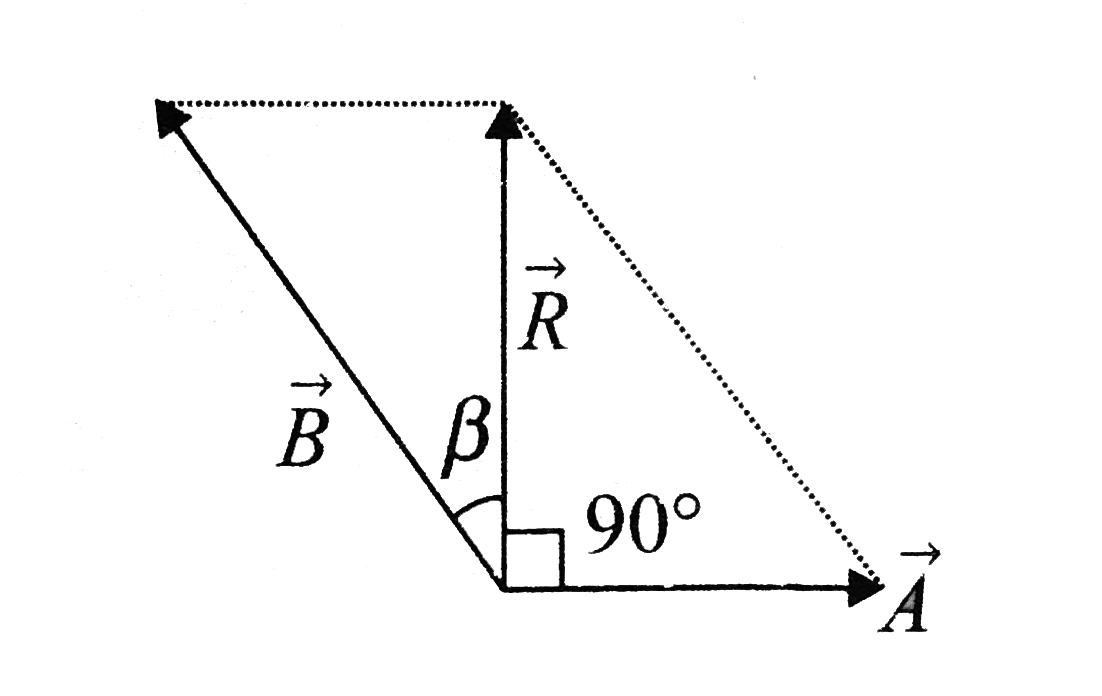The resultant of →a and →b makes α with →a and β with →b, then (a,b represent magnitudes of respective vectors) :
α<β
α<βifa<b
α<βifa>b
α<βifa=b
The correct Answer is:C
To solve the problem, we need to analyze the relationship between the angles α and β formed by the resultant vector with vectors A and B, respectively. Here’s a step-by-step breakdown of the solution:
Step 1: Understand the Problem
We have two vectors, A and B, with magnitudes a and b. The resultant vector R makes an angle α with vector A and an angle β with vector B.
Step 2: Apply the Law of Sines
According to the law of sines in the context of vector addition, we can relate the angles and the magnitudes of the vectors:
asin(β)=bsin(α)=Rsin(θ)
where θ is the angle between vectors A and B.
Step 3: Analyze the Angles
From the above relationship, we can derive:
ab=sin(β)sin(α)
This implies that the ratio of the magnitudes of the vectors is equal to the ratio of the sines of the angles they make with the resultant.
Step 4: Determine the Relationship Between α and β
- If a>b, then ab>1, which implies sin(β)>sin(α). Since the sine function is increasing in the range 0∘ to 90∘, this means β>α.
- Conversely, if b>a, then ab<1, which implies sin(β)<sin(α), leading to β<α.
Step 5: Conclusion
The relationship between the angles α and β depends on the magnitudes of the vectors A and B:
- If a>b, then β>α.
- If b>a, then α>β.
- If a=b, then α=β.
Final Answer
Thus, we can conclude that the angles α and β are related to the magnitudes of the vectors A and B. The correct statement is:
- If a>b, then β>α (Option C is correct).
We have two vectors, A and B, with magnitudes a and b. The resultant vector R makes an angle α with vector A and an angle β with vector B.
According to the law of sines in the context of vector addition, we can relate the angles and the magnitudes of the vectors:
asin(β)=bsin(α)=Rsin(θ)
where θ is the angle between vectors A and B.
From the above relationship, we can derive:
ab=sin(β)sin(α)
This implies that the ratio of the magnitudes of the vectors is equal to the ratio of the sines of the angles they make with the resultant.
- If a>b, then ab>1, which implies sin(β)>sin(α). Since the sine function is increasing in the range 0∘ to 90∘, this means β>α.
- Conversely, if b>a, then ab<1, which implies sin(β)<sin(α), leading to β<α.
The relationship between the angles α and β depends on the magnitudes of the vectors A and B:
- If a>b, then β>α.
- If b>a, then α>β.
- If a=b, then α=β.
Thus, we can conclude that the angles α and β are related to the magnitudes of the vectors A and B. The correct statement is:
- If a>b, then β>α (Option C is correct).
Topper's Solved these Questions
- BOOK - ANURAG MISHRACHAPTER - DESCRIPTION OF MOTIONEXERCISE - Level-225videos
DESCRIPTION OF MOTION
- BOOK - ANURAG MISHRACHAPTER - DESCRIPTION OF MOTIONEXERCISE - Level-334videos
DESCRIPTION OF MOTION
- BOOK - ANURAG MISHRACHAPTER - DESCRIPTION OF MOTIONEXERCISE - Example127videos
DESCRIPTION OF MOTION
- BOOK - ANURAG MISHRACHAPTER - FORCE ANALYSISEXERCISE - Matching type13videos
FORCE ANALYSIS
Similar Questions
The resultant of two velocity vectors →A and →B is perpendicular to →A. Magnitude of Resultant →R is equal to half magnitude of →B. If the angle between →A and →B is (30θ)∘, then value of θ is ?
View SolutionThe resultant of two vectors →Aand→B perpendicular to the vector →Aanditsmagnitudequal→halfofthemagnitudeofthe→−−→r vec B.F∈doutthe∠between vec A and vec B.
View Solution
Knowledge Check
- Question 1 - Select One
The resultant of →A and →B makes an angle α with →A and ω with →B , then:-
Aα<βBα<β if A<BCα<β if A>BDα<βif A=B - Question 2 - Select One
The resultant of two vectors →A and →B is perpendicular to the vector →A and its magnitudes is equal to half of the magnitudes of vector →B (figure). The angle between →A and →B is
 A120∘B150∘C135∘DNone of these
A120∘B150∘C135∘DNone of these - Question 3 - Select One
The resultant of two vectors →Aand→B is perpendicular to the vector →A and its magnitude is equal to half the magnitude of vector →B. What is the angle between →Aand→B ?
A30∘B45∘C150∘D120∘
The magnitude of the resultant of →A+→B and →A−→B is
View SolutionIf →a and →b are two vectors such that (→a+→b).→a−→b=0 find the relation between the magnitudes of →a and →b.
View Solutionthe resultant of two vectors →a&→b is perpendicular to →a. If ∣∣→b∣∣=√2|→a| show that the resultant of 2→a&→b is perpendicular to →b .
View SolutionTwo vectors →Aand→B inclined at an angle θ have a resultant →R which makes an angle α with →A. If the directions of →Aand→B are interchanged, the resultant will have the same
View SolutionIf →a.→b=∣∣→a×→b∣∣, then angle between vector →a and vector →b is :
View Solution

